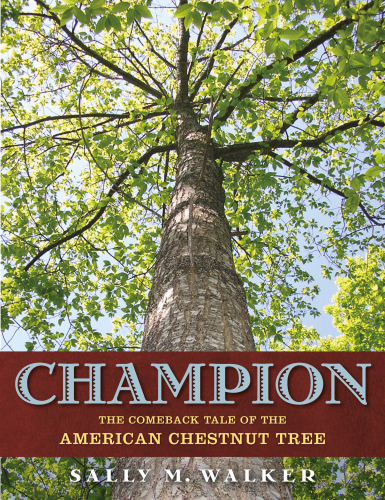
Champion
The Comeback Tale of the American Chestnut Tree
فرمت کتاب
ebook
تاریخ انتشار
2018
Lexile Score
1070
Reading Level
6-9
ATOS
7.6
Interest Level
4-8(MG)
نویسنده
Sally M. Walkerشابک
9781250125248
کتاب های مرتبط
- اطلاعات
- نقد و بررسی
- دیدگاه کاربران
نقد و بررسی

February 15, 2018
Once a ubiquitous presence in North America's eastern forests, the American chestnut tree was nearly brought to extinction by a deadly blight, but it was brought back from oblivion through the ingenuity of determined scientists. In 1904, forester Hermann Merkel discovered ugly wounds on some of the American chestnut trees in the New York Zoological Park. No other trees in the park were affected. By 1911, only two of 1,500 trees in the park remained. A scientist with the New York Botanical Garden identified the disease as a blight fungus. All attempts to find a remedy failed. A U.S. Department of Agriculture scientist discovered that the blight originated in Asia, brought to the United States through the cross-breeding of the American and Asian chestnuts. By 1940, nearly 4 billion trees succumbed to the devastating blight. Using clear, accessible language, Walker explains how research scientists have developed three promising approaches to restoring the American chestnut: backcross breeding, using weak strains of virus-infected fungus to attack lethal strains, and engineering transgenic American chestnut trees. These approaches are cause for cautious optimism for restoration of the trees, which Walker describes as a "gargantuan task," requiring "time and patience." Walker's passion for her subject and her ability to convincingly explain how the American chestnut is an icon worth saving makes this stand out.A compelling, inspiring true story of a species rescued from extinction through decades of determined innovation. (photos, appendices, source notes, glossary, bibliography) (Nonfiction. 10-14)
COPYRIGHT(2018) Kirkus Reviews, ALL RIGHTS RESERVED.

March 1, 2018
Gr 5-8-The award-winning nonfiction author brings to light the intriguing story of the beleaguered American chestnut tree. It was a staple of the forests, long-lived and large, with abundant tree nuts for wildlife-some lived up to 600 years and grew up to 100 feet tall. Walker briefly discusses how the Cherokee and the Iroquois used its leaves for medicine and the Lenape crafted its trunks for dugout canoes. Its wood is resistant to rot, and colonists and settlers also saw its enormous value. The author describes how a tiny fungus inadvertently introduced to the United States nearly decimated the entire American chestnut tree population across the nation. She ably integrates the human interest aspect of those involved in first spotting, identifying, and then developing approaches to solve the problem. The book reads much like a mystery, one that emphasizes the dire impact of an invasive species. VERDICT This fascinating and well-sourced tale will appeal to students interested in environmental issues, biology, and ecology. It could easily be integrated into science class units.-Gretchen Crowley, formerly at Alexandria City Public Libraries, VA
Copyright 2018 School Library Journal, LLC Used with permission.

March 1, 2018
Grades 5-8 When Hermann Merkel was hired in 1898 to be New York Zoological Park's chief forester, the 1,500 American chestnut trees were his favorites. In 1904, Merkel noticed a blight that was quickly destroying these beloved trees, and by 1911, only 2 remained. Merkel's observations were the start of a scientific mystery with ramifications that still continue. Walker documents some of the many scientists, from the beginning of the blight to today, who have worked to save this American icon. Why all the interest in a tree? The author first explains the importance of the American chestnut on the eastern forests' environment. The bulk of the investigative text, however, concentrates on the source of the blight and three different approaches to saving the American chestnut. In the process, Walker shows how the comeback of this tree can serve as a model to restore other species. The niche subject may be a hard sell to recreational readers, but with additional photos of scientists in action, this STEM volume is a boon to life-science and engineering units.(Reprinted with permission of Booklist, copyright 2018, American Library Association.)

























دیدگاه کاربران